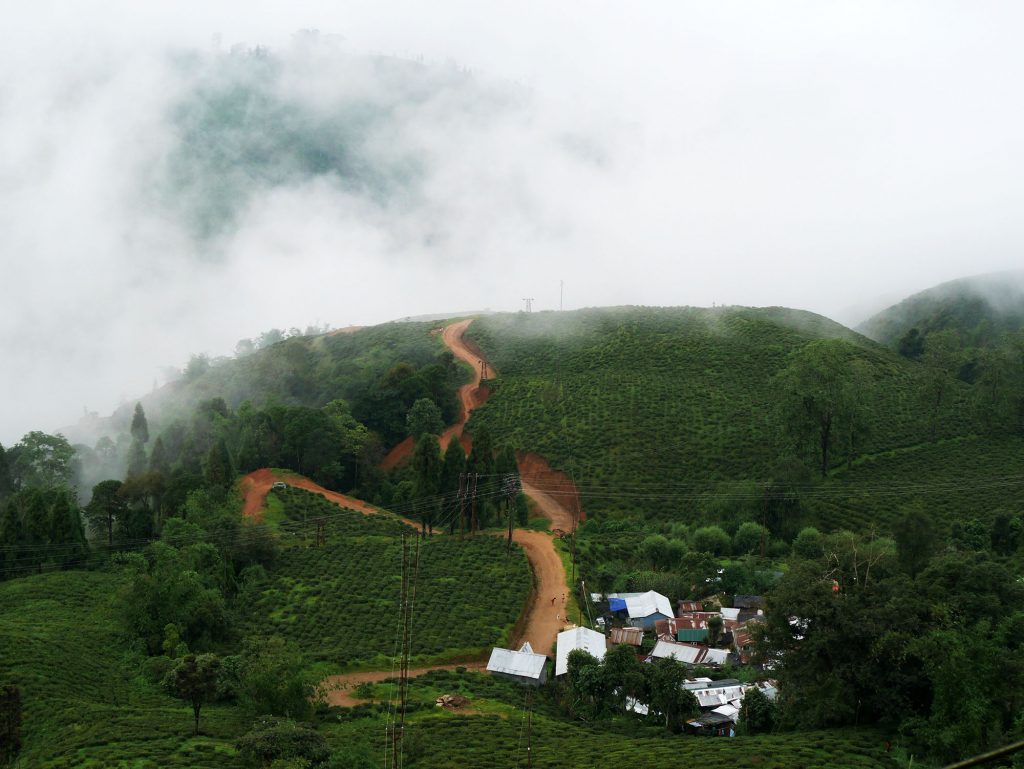Our month-long trip to India became a series of pointing out places in the map and saying, “okay, let’s go there. There. And there. And perhaps there?” without fully knowing the travel time and route they entailed.
Delhi, Agra, and Varanasi are the usual destinations for first-time travelers like us, but we ambitioned to see more of India to have a better understanding of the seventh largest country in the world.
Sikkim was the “perhaps there?” place. So was Darjeeling. We made it to Darjeeling after an overpriced overnight train ride from Varanasi. Aside from this reason, I wanted to see the actual place of Kiran Desai’s The Inheritance of Loss. Our trip to Kerala was born from the same reason: to see Arundhati Roy’s The God of Small Things.

My love for literature prods me to see the places I first heard about from books. But being a tourist, an outsider, makes me removed from the layers of issues a place has, which are deeply addressed in Indian literature. Experiencing places in their subtle and ordinary ways works fine for me. I can’t possibly demand a place to show everything in a quite short period.
Fog, the shade of stainless steel, and intermittent rain persisted throughout our short stay in Darjeeling. It was July—northern India’s contradicting summer: wet and muggy. Despite the relative nearness of Sikkim, we did not make it there.

Besides the unfriendly weather, locals—some of the friendliest we have encountered—discouraged us to do so. There was unrest going on in Sikkim. But then again, there is always unrest in India or anywhere in the world, including the Philippines. It was the weather that dissuaded us from visiting the place. July, according to the local, is not the best time to visit northern India.Our clothes became damp, the fog became part of our skin.
But not visiting Sikkim is a reason to come back to India and explore its multicultural and vibrant places. Perhaps, I will avail of Sikkim tour packages to see a different perspective of the place. Perhaps I will talk more with the people and learn about their own sadness and struggles. Perhaps. Perhaps.
Meanwhile, here is a travel guide of Sikkim tourism that I will follow in the future. Definitely.

Sikkim Travel Guide
As early as 1975, Sikkim was an autonomous mountain kingdom of the Himalayas, a personality it retains till this day. The warm-hearted, predominantly Nepali and Hindu communities, along with a sprinkling of Tibetan Buddhists coexist in total communal harmony, making Sikkim a friendly and hassle-free place to visit.
As the clouds clear and the sun rises over the northwest horizon,the dense and steep valleys rise to merge with the lofty and stunning Kanchenjunga mountain ranges, which have some of the highest peaks in the world. Sikkim is not only clean but also green, with the state going totally organic since 2016. The main draws for visitors are its more than 200 monasteries and excellent opportunities for trekking.
Getting there
Being a landlocked state, entry to Sikkim is primarily through West Bengal. The nearest railway station is New Jalpaiguri, and Bagdogra is the connecting airport. Both of which are roughly a three-hour ride away from the capital, Gangtok.
What to see in and around Gangtok
Gangtok is the best for rest and relaxation. It makes an ideal base to explore the rest of the state. The clean mountain air and postcard beauty attracts tourists in large numbers to this land of monasteries.
Thousands of visitors flock to Nathula, located 55 km from Gangtok to view the spectacular views of the Himalayas. As the place is under army control because of its strategic location, special permits need to be obtained a day in advance to visit Nathula. These are, however, easily obtainable from Gangtok. Tsomgo lake, Baba Mandir and the Kyongnosla Alpine Sanctuary all lie on the way to Nathula and are must-see spots.
The Rumtek monastery, the largest in Sikkim, lies 23 km from Gangtok, at an altitude of 5000 feet. The monastery is said to house the mortal remains of the 16th Karmapa inside the Golden Stupa. Ganesh Tok and Hanuman Tok are the two popular viewpoints, about 6 km away from Gangtok, which provide the best views of the Eastern Himalayas, including Kanchenjunga, the third highest peak in the world.
North Sikkim
At a distance of 120 km from Gangtok, Lachung is a place of surreal beauty. Snow-covered mountains, waterfalls, and rushing streams make it an ideal destination from the busy town of Gangtok. Lachung Gompa, Yumthang Valley, and Yumesamdong (zero point) are the other attractions.
West Sikkim
The tiny, but very popular, hamlet of Pelling lies 115 km from Gangtok. Tourists are rewarded with spectacular views of the Kanchenjunga range from Pelling. Two kilometers away is the Pemayangtse Monastery, which is deemed to be one of the oldest in Sikkim. Other important sights are the Rabdentse Ruins, the former capital of Sikkim, which was ravaged by Nepali invaders in the 18th century.
The unspoilt town of Yuksom offers plenty of trekking opportunities and is also the gateway to the Kanchenjunga National Park, known for its diverse bird life and the elusive snow leopard.
South Sikkim
The small settlement of Namchi lies 80 km away from Gangtok and provides great views of Darjeeling and Kalimpong towns in West Bengal. The highest statue of Guru Padmasambhava is located at Samdruptse Hill. The sacred site of Solophok Chardham is situated just 5 km from Namchi.
Ravangla, is another famous spot of south Sikkim, known more for its laidback atmosphere and tranquility.The neighboring attractions here are Ralang Monastery, Buddha Park, and Ralong Hot Springs.
Outdoor activities
There are many reliable agencies available to provide this thrilling experience on the Teesta River rapids. With dense forests and scenic villages on either side, river rafting here is a lifetime experience. Trekking, mountain biking, paragliding, and the unique yak safari all make for an unforgettable holiday in Sikkim.
Eating out
Savoring local delicacies are the high point of any vacation. Here in Sikkim, the presence of so many different ethnic communities has created an amazing food culture. Some of the must-try dishes here are thukpa, momos, kinema curry, sel roti, mesu, pakku, and the traditional soup sishnu.
Shopping
No holiday trip is complete without indulging in a bit of shopping, and Sikkim is no exception. The traditional handicrafts of Sikkim, Thangka paintings, prayer wheels, Lepcha weave bags, Choksi tablets, and Tibetan crockery can be found in various markets.
Things to remember
Most of the tourist spots in Sikkim are situated in restricted zones, necessitating the need of permits to visit. Depending on where you plan to go, apply well in advance to the concerned government department. Finally, respect the local tradition and culture and ensure cleanliness everywhere.
ABOUT THE AUTHOR
Jona Branzuela Bering, Palanca awardee and author of the poetry collection Alang sa Nasaag (For the Lost), blogs at Backpacking with a Book. She left her beautiful life in Cebu to pursue her goal of traveling long-term abroad. She’s currently based in Hanoi, Vietnam.










